In 2014, George Osborne made headlines as he announced the UK government’s intention to redeem bonds stretching back as far as the eighteenth century. This included First World War debt, as well as bonds issued during the South Sea Bubble crisis (1720) and the Napoleonic wars (1803-1815).1
The human interest element of the story is surely what caught the public’s attention. But it serves to emphasise two important, if somewhat elementary, points:
- Governments can issue debt over long periods of time (these bonds were ‘perpetuals’, with no maturity date).
- The fate of a nation can change a lot during the lifetime of a bond.
Even if we meet the Paris target and keep global warming well below 2˚C – which is looking increasingly unlikely – it is hard to imagine a world where climate change doesn’t cause significant economic disruption. How different will sovereign creditworthiness look by 2050?
Temperature rises will negatively impact GDP
A recent report from the Intergovernmental Panel on Climate Change (IPCC) finds that ‘some vulnerable regions, including small islands and Least Developed Countries (LDCs), are projected to experience high multiple interrelated climate risks, even at global warming of 1.5°C'.2
Our first chart, based on projections from the Swiss Re Institute, suggests that global temperature rises will negatively impact GDP in all regions by 2050, with the losses increasing significantly as the temperature scenarios ramp up.




